A strange summer for Jake Gardiner finally came to a close on Sept. 6 as he signed a four-year deal worth $4.05 million per season with the Carolina Hurricanes. As the undisputed top defenceman in free agency this offseason, many were left scratching their heads as he remained unsigned for over two months. There were questions about the health of his back, of course, but being just two years removed from a 52-point season in 2017-18, his ability is unquestionable.

It was almost a foregone conclusion that Gardiner would not be returning to the Toronto Maple Leafs given their cap constraints. But with the announcement of his bargain bin deal with Carolina, there are more questions than answers.
Why couldn’t the Maple Leafs have offered him a similar contract? Why did they take Cody Ceci from Ottawa in the Nikita Zaitsev trade? And then why did they extend him, essentially giving him Gardiner’s money?
No matter how you spin it, his new contract looks terrible on the Maple Leafs. And it may just be their biggest misstep of the summer.
Gardiner’s Value
Gardiner has been known as an analytics darling for years now, but even if you don’t subscribe to the statistical side of hockey, it’s clear that his contract is a steal.
His average annual value (AAV) of $4.05 million ranks him as the 82nd-highest paid defenceman in the league. He makes less than names like Ceci, Zaitsev, Karl Alzner, Zach Bogosian, plus the recently signed Anton Stralman and Tyler Myers.
Let’s compare some of these players for reference.
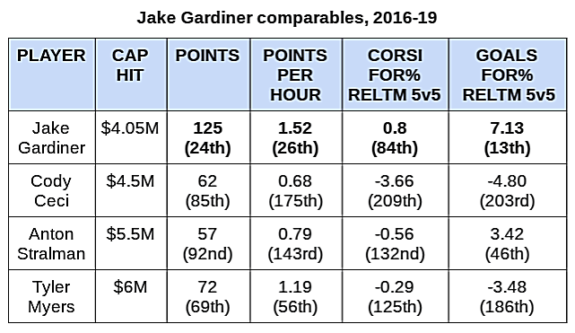
By most of the vital measures, Gardiner comes out as a top-pairing defender. He produces extremely well, and his team simply dominates shots and goals when he’s on the ice. Even while playing on a star-studded Maple Leafs squad, he outshines his teammates when it comes to relative metrics. Meanwhile, his counterparts are all outshot and outscored (except Stralman, who does show up favourably in terms of on-ice goals), and yet they’ll all be making more than Gardiner this season.
If you want to dig even deeper, Gardiner is the ninth-best defencemen in terms of goals above replacement (GAR) over the last three seasons. GAR measures a player’s impacts based on even-strength contributions, powerplay offence, shorthanded defence, and penalties (drawn and taken). For him to be among the top-10 defencemen over a significant period of time really illustrates how valuable – and underrated – he is.
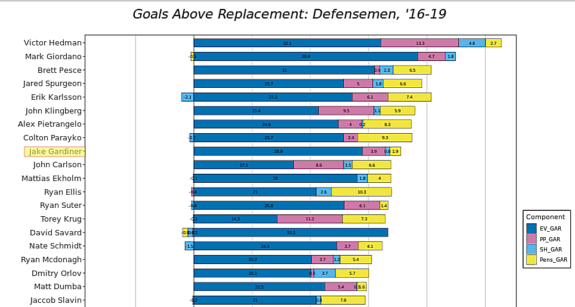
If you subscribe to the notion that Gardiner is, in fact, a top-10 defenceman, he should be paid around $7.5 million, yet he’s making just over half of that. If you’re more conservative in your evaluation of him and want to place him around the 30 range, that’s fair too. Even then, he’s worth at least $5.5-6 million.
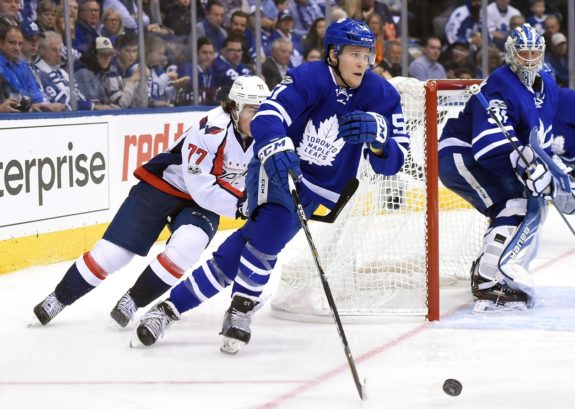
Carolina got a steal, and the Maple Leafs missed out. Now they’ll enter the season with Ceci, one of the league’s worst 5-on-5 defenders, in their top-four. What could have been an elite defensive corps of Morgan Rielly, Jake Muzzin, Tyson Barrie, and Gardiner will now remain a question mark. Of course, you cannot simply paint the issue as a one-for-one choice of Ceci over Gardiner: Ceci was acquired to get rid of Zaitsev and his contract, while Barrie is a more direct replacement for Gardiner. But even then, Gardiner is better than Barrie by most measures. And given what Gardiner eventually signed for, there must be serious questions – and doubts – about the Maple Leafs’ front office.
What Was Dubas Thinking?
That leads us to the first, most obvious question: what was Maple Leafs general manager Kyle Dubas thinking by letting Gardiner get away for so little?
And the avalanche just rolls on from there…
Why Sign Ceci if Gardiner Would Take Less?
The prevailing logic behind acquiring Ceci is that it allowed the Maple Leafs to get out from under Zaitsev and the remaining five years of his $4.5 million contract. That’s fine and dandy. Where the confusion comes in is when the Maple Leafs opted to extend Ceci for $4.5 million.

The rules of the NHL’s collective bargaining agreement can be a little tricky, but in short, Ceci was a restricted free agent with arbitration rights. And because the Senators had qualified Ceci prior to the trade, the Maple Leafs had to honor that and his arbitration rights. Instead, the Maple Leafs and Ceci agreed on his one-year, $4.5-million contract and avoided arbitration. That move may have benefited the team as they would have had to agree to the salary proposed by the arbitrator.
Of course, we don’t know where contract talks were at with Gardiner on July 4 when Ceci signed; they may have been nowhere near on money or term. But when it comes down to it, Dubas elected to extend Ceci for one year rather than bring back Gardiner, the vastly superior player, for a few more seasons. It’s a head-scratcher to be sure.
Why Let Gardiner Walk When Both Barrie and Muzzin Are Pending UFAs?
Even without Gardiner, the Maple Leafs’ defence is still in a good spot for the coming season. Once Travis Dermott returns from injury, a top-four of Rielly, Muzzin, Barrie, and Dermott would be very strong (that may be asking for too much from head coach Mike Babcock, though).
But aside from the current implications of Gardiner leaving, there’s an issue for next season: only Rielly is signed. And the rest of the top-four won’t be easy to lock up by any means. Dermott will need an extension that will likely place him in the same monetary range as Gardiner. Muzzin will be 31 next year – right around the age where a decline in ability is imminent – and he’ll also command more than Gardiner’s $4.05 million. Finally, Barrie will likely put up monstrous numbers and he won’t be short of suitors as a 28-year-old free agent. There’s already been speculation that he could command as much as $8 million per season next summer.
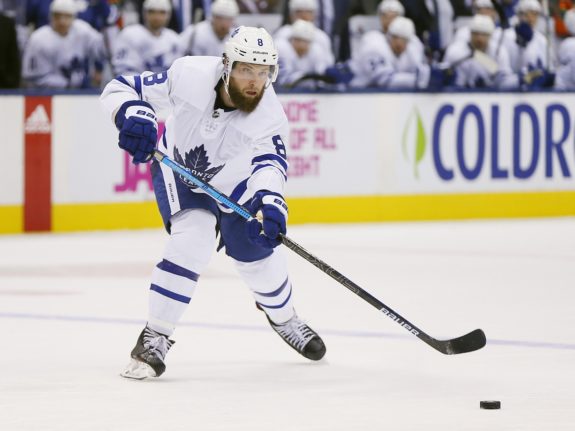
Being realistic about 2020-21, the Maple Leafs will have Rielly signed for two more years at $5 million, Dermott at around $4 million (highly dependent on term), and they’ll likely sign Barrie over Muzzin due to the age difference. We’ll pencil in Barrie at $7 million as a very rough estimate. That leaves the team with just three top-four defenders at a total of $16 million. Now there are some options to fill in the gaps, but you’ll see that they’re all worse options than Gardiner at $4.05 million.
Option one is free agency, and there are some intriguing names on the board: Alex Pietrangelo, Torey Krug, Jared Spurgeon, Sami Vatanen, Justin Faulk and TJ Brodie headline a stacked UFA market. The problem is that all of these players currently make more than $4.5 million and will likely demand an even bigger number in free agency. And there’s reason to believe that Gardiner is better than most of them – and certainly more valuable at his cap hit.
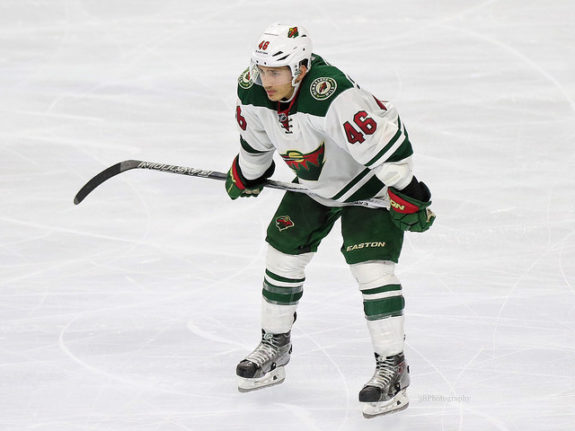
The second option is internal promotion. The Maple Leafs have some promising prospects in current Toronto Marlies Rasmus Sandin and Timothy Liljegren, who will be 20 and 21-years old next summer, respectively. But unless one or both of the young Swedes get significant NHL time this season, it’ll be a huge ask to slot them into a top-four role in 2020-21.

As you can see, there is no easy or obvious path forward for the Maple Leafs’ defence after Gardiner’s departure. They’re left with at least one gaping hole in their top-four after this season and no obvious immediate replacements. The fact that he signed for pennies on the dollar only makes it worse.
Is Gardiner’s Back Still an Issue?
One possible explanation for Dubas’ hesitancy to bring back Gardiner is his health. He first left the lineup on Feb. 25 with a back injury and ended up missing 18 regular-season games. Even upon returning in the playoffs He didn’t look himself, being relegated to third-pairing duty due to his obvious lack of mobility.

You can see why other GMs around the league might be leery as well. At 29 years of age, Gardiner is at the end of his prime; he will likely be in decline over the next few seasons. On top of that, a back injury is a serious issue so it’s reasonable to assume that GMs were scared off by both his age and injury. No one wants to be the guy that hands out the next albatross contract. But when we examine the surrounding context, it’s truly ridiculous how little interest the top UFA defenceman garnered.
The aforementioned Myers signed with the Vancouver Canucks for five years with an AAV of $6 million, making him the 24th-highest-paid defenceman in the league. While he is 6-foot-8 and has demonstrated above-average offensive ability, he is nowhere near a top-pairing defenceman. His signing, when compared to Gardiner’s deal, truly highlights just how far behind some GMs are when it comes to evaluating player ability.
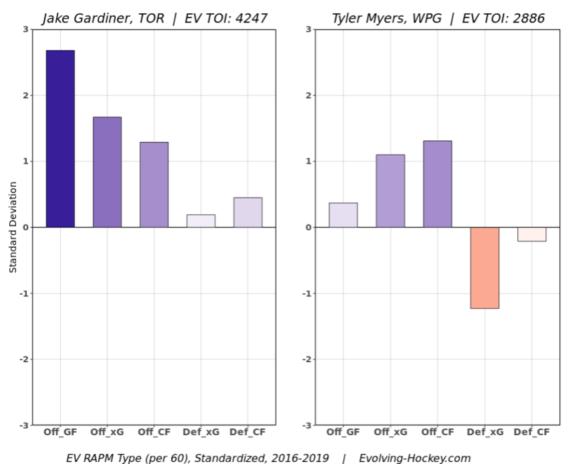
Gardiner’s exit ultimately marks the end of an era: he and Nazem Kadri were the last remaining members of the 2013 team that infamously collapsed in Game 7 against the Boston Bruins. For some fans, it was time for the polarizing defenceman to move on and make way for some new blood. The hope now for the Maple Leafs is that this new look blue line can live up to expectations and perhaps win a playoff series – something the Gardiner-era Leafs could never accomplish.